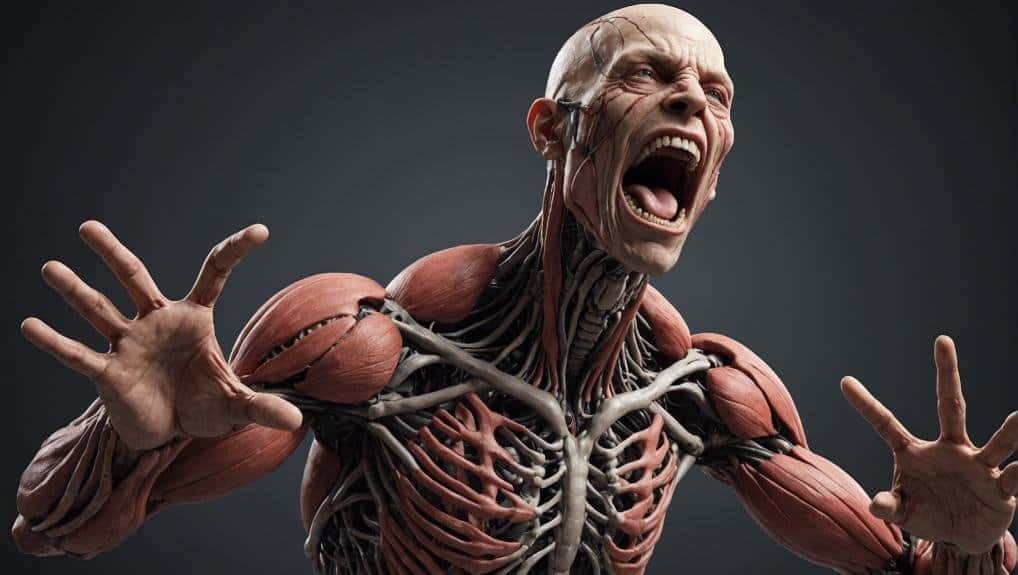Sensory Systems Unveiled: The Homunculus Revealed
|
Getting your Trinity Audio player ready...
|
You might be thinking that the idea of a homunculus sounds overly complex or esoteric, but bear with us for a moment. As we explore the intricacies of sensory systems and the homunculus concept, a fascinating journey unfolds. The homunculus, representing sensory receptors on a distorted human figure, offers a unique perspective on how our brains interpret and prioritize sensory information. Join us as we uncover the mysteries behind this intriguing concept and investigate the implications it holds for our understanding of perception and cognition.
Key Takeaways
- The homunculus concept illustrates distorted body parts representation.
- Sensory map shows brain's prioritization based on acuity and importance.
- Insights into brain's processing of sensory information gained.
- Detailed sensory representation reveals weighted significance of sensory receptors.
- Brain organizes sensory inputs to create proportional body map.
Sensory Systems Overview
Exploring the intricate network of sensory systems reveals a vital interplay of sensory input and neural processing, shaping our perception of the world around us. The human body integrates multiple sensory modalities to construct a holistic understanding of our environment.
Sound waves, for instance, are transduced into electrical signals by the ear, which are then interpreted by the auditory cortex in the brain. Taste buds house taste receptor cells that distinguish between various flavors, while smell receptors in the olfactory bulb contribute to our overall taste perception.
These sensory interactions can lead to cross-modal experiences, showcasing the brain's remarkable ability to process and integrate information from different sources. Understanding these processes is essential for unraveling the mysteries of human perception.
The Homunculus Concept Explained
Delving into the homunculus concept reveals a detailed sensory map illustrating the proportional representation of the human body based on sensory input and the weighted significance of sensory receptors. This concept highlights the brain's organization of sensory information, with areas dedicated to different body regions based on sensory acuity and importance.
The homunculus representation showcases how our brains prioritize certain sensory inputs over others, leading to a visual depiction of distorted body parts to reflect their sensory significance. By understanding the homunculus concept, we gain insights into how our brains process and prioritize sensory information, shaping our perception of the world around us.
This detailed map serves as a fundamental framework for comprehending the intricacies of sensory processing and the human brain's remarkable abilities.
Auditory Perception Insights
With a complex network of structures and processes, auditory perception intricately decodes sound waves into meaningful signals for the brain to interpret.
Sound waves travel through the air, entering the ear canal and striking the eardrum, causing it to vibrate. These vibrations are then transmitted through the ossicles in the middle ear to the cochlea, a spiral-shaped organ filled with fluid.
Inside the cochlea, specialized hair cells convert the vibrations into electrical impulses, which are sent along the auditory nerve to the brain for processing. The brain's auditory cortex analyzes these signals to determine the pitch, volume, and direction of the sound, allowing us to perceive and make sense of the auditory world around us.
Taste and Smell Connection
The connection between taste and smell is intricately intertwined, shaping our sensory experiences and influencing our perception of flavors.
- Smell receptors in the nose send signals to the brain, affecting how we taste food.
- Taste buds on the tongue detect basic tastes like sweet, salty, sour, bitter, and umami.
- When taste and smell combine, they create a richer sensory experience, enhancing our enjoyment of food.
- Our brain processes these signals together, creating a cohesive perception of flavor.
These senses work in harmony, allowing us to savor and distinguish the intricate nuances of the foods we consume.
Importance of the Sense of Touch
Moving from the intricate connection between taste and smell, we now shift our focus to the significance of the sense of touch in shaping human sensory experiences and development.
The sense of touch plays an important role in early development, with studies showing that physical contact is essential for infants' growth and well-being. Touch receptors in the skin transmit information about pressure, temperature, and pain, contributing to our awareness of the environment. This sensory input is important for social bonding, emotional regulation, and spatial awareness.
The tactile system also works in conjunction with other sensory modalities to provide a thorough understanding of the body's position and movement, highlighting the integrative nature of human sensory functions.
Kinesthetic and Vestibular Functions
Detecting body movement and positioning, the kinesthetic sense operates independently of other senses, important for activities like walking, dancing, and swimming. This sense is essential for our daily movements and spatial awareness.
Here are four key points to keep in mind about kinesthetic and vestibular functions:
- Kinesthetic sense integrates with other sensory inputs to provide a comprehensive understanding of body positioning.
- Vestibular sense contributes to balance and equilibrium, working in tandem with the kinesthetic sense.
- Both senses play a significant role in activities requiring coordination and precision, such as sports and dance.
- Dysfunction in these senses can lead to difficulties in movement, coordination, and spatial orientation, affecting daily functioning.
Role of Sensory Perception Systems
Operating independently of other sensory functions, the role of sensory perception systems lies in decoding and interpreting various stimuli to construct our conscious reality. These systems play a critical role in shaping our understanding of the world around us.
Through intricate neural pathways and processing centers in the brain, sensory perception systems convert stimuli such as light, sound, taste, smell, and touch into meaningful information that we can comprehend and respond to. By integrating input from different sensory modalities, our perception systems allow us to navigate our environment, make decisions, and interact with others effectively.
Understanding the mechanisms behind sensory perception is essential for unraveling the complexities of human cognition and behavior. The interplay of these systems forms the foundation of our sensory experiences and ultimately shapes our perception of reality.
Conclusion
To sum up, the homunculus concept serves as a vivid illustration of the brain's intricate sensory processing mechanisms. By mapping out the body's sensory receptors in a proportional manner, we gain valuable insights into how the brain prioritizes and integrates sensory inputs.
This detailed representation provides a visual roadmap of our perception, highlighting the importance of different sensory systems in shaping our understanding of the world around us.








